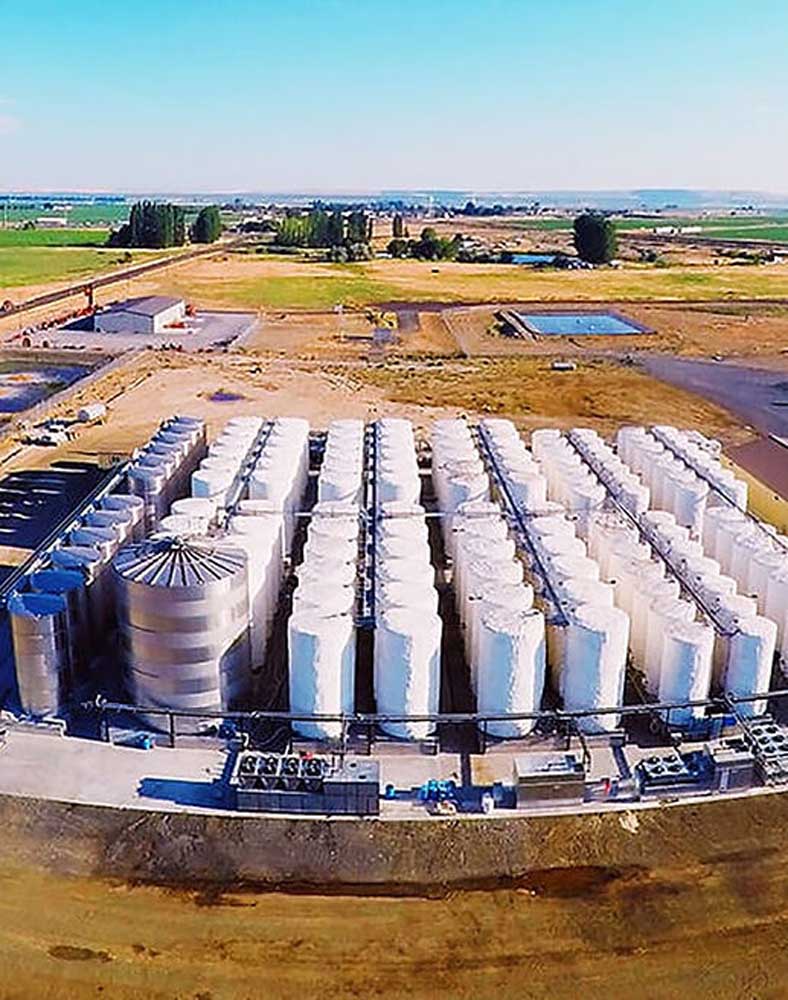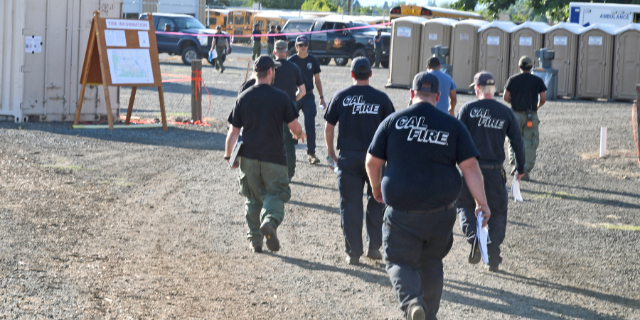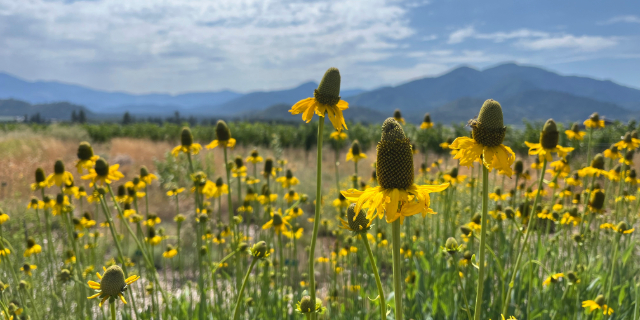Despite current challenges, Washington’s winery owners see bright future
Published 9:30 am Thursday, September 12, 2024

- An aerial shot of Ancient Lakes winery at George, Wash., showing over 3 million gallons of temperature-controlled stainless steel tanks.
GEORGE, Wash. — It began in 1997 with two brothers branching out from potatoes and alfalfa into a tantalizing new adventure of growing their first 100 acres of winegrapes on Washington’s Wahluke Slope.
Trending
Today, that first vineyard has grown into RM Wineries, one of Washington’s top three wine producers. Like the entire industry, it is coping with a significant downturn caused by a global oversupply and shrinking consumer demand.
Long known as Milbrandt Wine and Vineyards, the winery management portion of the company became RM Wineries — for Rice Milbrandt — in 2021. That’s when Brandon Rice, now 39, winemaker and manager at the company’s Ancient Lake Winery at George, Wash., became managing partner and equal owner with Jerry Milbrandt, one of the founding brothers.
Rice says the company will weather the downturn because of local rather than national-corporate ownership, multiple custom processing clients and a growing number of its own labels: Alki, Caliche, Rhody, Slope, Alki Reserve, 1889 and Evergreen.
Trending
Rice believes Washington has the best climate in the world for growing winegrapes. The state industry is still young at about 45 years old and people outside the Northwest are just beginning to learn about it, he says.
“2016 and 2018 were our largest harvests in the history of Washington. They were massive crops which got us to the point of overproduction. It wasn’t just here but worldwide,” Rice said.
“COVID accentuated that because during COVID wine consumption went up,” he says. “People planted more vineyard expecting continued growth but post-COVID consumption dropped.”
About 70% of the wine produced at RM Wineries is from company-affiliated vineyards and goes into the company’s seven labels and other bottled or bulk sales.
The remaining 30% is from winegrapes of other growers. Fermentation is segregated by client, variety and vineyard. RM offers label design and production. The growers or their agents handle sales.
RM Wineries is the state’s largest family-owned grape-to-bottle operation, meaning vineyards, production and bottling. It uses about 28,000 tons of winegrapes annually to produce 2 million cases, which equals 5 million gallons of wine.
Coventry Vale Winery, of Grandview, is larger in grape tonnage but does no bottling.
Chateau Ste. Michelle Wine Estates, of Woodinville, is by far the largest company and produces 7 million cases annually, about half of the state’s total. It is publicly owned and has been sold twice in recent years.
A year ago, Ste. Michelle reduced the tonnage it buys from independent growers by 40%, resulting in hard times for many of those growers. Ste. Michelle has since sold two of its subsidiary wineries.
“It’s a sign of maturity. Ste. Michelle nursed us along. Now we need to develop on our own,” Ryan Flanagan, a partner with the Milbrandts in the vineyards, says, referring to the state industry.
He says after this fall’s harvest he will likely eliminate 200 acres to counter overproduction.
Flanagan, owner of Flanagan Family Vineyards and manager of Spanish Castle, Evergreen and Ancient Lakes vineyards for the Milbrandts, has become a closer partner with the Milbrandts in some of their vineyards. The total is about 3,300 acres in the Ancient Lake and Wahluke American Viticultural Areas, known as AVAs.
Ste. Michelle, Coventry and RM account for 55% to 65% of the state’s grape tonnage, which was 168,000 tons in 2023, Rice says. That produced 11.25 million cases, or 26.5 million gallons of wine.
Rice says about 150,000 tons are expected this fall due to vineyards being torn out and others experiencing freeze damage from last winter.
Washington production peaked at 270,000 tons in 2016 valued at $313 million, which was second to California’s 4 million tons valued at $3.6 billion, according to USDA National Agricultural Statistics Service.
Best region
Hot days, cool nights, little rain and pest-killing winter freezes all make Washington the best winegrape-growing region in the world, Rice says.
“California can produce a lot more because it has a longer growing season but it has pest issues that we don’t because we freeze in winter,” Rice said. “So we use less pesticides.”
France has a wetter climate and more humidity and therefore uses more herbicides.
Washington has about 300 days of sunshine annually, hot days and cold nights for optimum ripening and flavor and less than 6 inches of precipitation in much of the winegrape region.
“We’re considered a desert, which allows us to control the amount of water through drip irrigation to increase quality,” he said. “Winter freezes for pest control is huge. Find another region that has all of that.”
California and Washington are “almost nil” compared with world production but there are “pockets around the world that will appreciate our wines for quality and price point,” he said.
California has 85% of U.S. wine shelf space, and Washington should be able to take another 2% of that, which would take care of its over production, he said.
Company roots
Butch Milbrandt, now 78, and his brother, Jerry, 75, were youngsters on their way to becoming fourth-generation farmers when their parents moved the family from the Midwest to Central Oregon and then to Quincy, Wash., in the 1950s. They bought 160 acres.
The brothers planted winegrapes in 1997. Other farmers were doing the same thing as a new way to make money. The Milbrandts were a contract supplier to Ste. Michelle in their early days.
By 2005, they had built their winegrape acreage to the point that they opened Wahluke Wine Company in Mattawa. They developed their Milbrandt label but also focused on small-lot, ultra-premium and luxury wines from top growers.
Jerry ran the plant. Butch was in charge of marketing and sales and the vineyards.
Today, the plant is regarded as one of the most efficient, ultra-premium wineries in the state with more than 80,000 square feet of climate-controlled barrel storage, a high-speed barrel line, multiple gentle presses, more than 3 million gallons of temperature-controlled stainless steel fermentation tanks and a state-of-the-art bottling line.
The brothers helped establish the Wahluke Slope AVA in 2006.
Wahluke is a Native American word that means watering place, and the slope is a great winegrape growing climate, among the warmest in the state with up to 210 frost-free days per year. It’s best for growing red winegrapes.
To the north, they helped develop the Ancient Lakes AVA in 2012. It’s named for 35 small lakes from pre-historic times where caliche rock provides great drainage and helps produce unique aromatic white wines. It’s a little higher in elevation, is cooler and has a large diural shift, the difference between average daytime high temperatures and average nighttime lows, that helps with acidity.
In 2014, the Milbrandts began the Ancient Lake Wine Company with large outdoor fermentation tanks just north of George. They hired 29-year-old Brandon Rice as winemaker and facility manager.
He was going to be a dentist
Rice was born and raised in Sunnyside, Wash., where his parents still operate a casino and bowling alley. Rice graduated from Washington State University in pre-med and was aiming toward becoming an orthodontist or an Air Force fighter pilot when he took a job as a lab technician at Ste. Michelle.
“2008 wasn’t the best time to graduate from college,” he says, referring to the Great Recession. “I didn’t know much about the wine industry but had a strong background in science and math. It was easy for me to jump into the lab. I fell in love with the wine industry.”
He worked for Goose Ridge Winery in Benton City and then was hired by the Milbrandts to help build and operate their new Ancient Lakes winery.
A unique winery
It’s the only winery in the state with all of its fermentation tanks outside. Each stainless steel tank is insulated, providing for greater control over fermentation than if they were uninsulated tanks inside a building, Rice says. Greater control enhances quality.
About 400 tanks, ranging from 18,000 gallons to 550,000 gallons, and 30,000 barrels make up more than a 6 million-gallon capacity. Large capacity is needed because white wines ferment 2 to 6 months and red wines 6 to 24 months before bottling.
There are multiple gentle grape presses and a high-speed bottling plant capable of bottling 250 bottles per minute, 10,000 cases per day and 2.2 million cases per year.
More than $23 million has been spent on the plant so far. Plans to increase to 8 million gallons have been put on hold due to the current saturation of the wine market.
There’s 40,000 square feet of climate-controlled, packed-case storage and 20,000 square feet for bottling, with plans for the total warehouse to eventually reach 750,000 square feet.
Lacking identity
Different wine-growing regions of the world are known for certain grape varieties.
“Napa is Cabernet Sauvignon. Oregon is really good Pinot noir. We are not that old here, so our story is yet to be told,” Flanagan said. “It’s hard for us to be defined because everything grows so well here in this climate. We’re having success with Albarino a white grape grown in Spain, but it looks like Riesling and Syrah are poking their heads up as unique.”
Ancient Lakes Riesling is being shipped all over the world, some even into Europe, which, he said, is unusual.
“We have a unique quality of wine and style of fruit that makes it desirable,” says Flanagan, the vineyard manager. “We have a unique area that grows world-class fruit across the board. winegrapes, apples, cherries and pears.”
Winegrapes from Milbrandt and Flanagan vineyards are sold to RM Wineries but also to other other wineries including Ste. Michelle.
Flanagan farming roots
Similar to the Milbrandts, the Flanagan family — Ryan’s dad, Terry, and granddad, Sid — broke farm ground in the Quincy area in the 1950s.
The Flanagan name was well-known in politics. Sid’s father, E.J., was a state senator from Wapato from 1943 to 1947. Sid was a state representative from 1961 to 1983. Both were Republicans.
Terry Flanagan “grew tired of the wind and dust” of farming and went into automotive work in Issaquah, where Ryan was raised.
He visited his cousins, the Jones family, on their Quincy farm. Ryan received his business degree from Gonzaga University in 1998 and began working under viticulturist Jim McFerran at Ste. Michelle’s Cold Creek vineyard south of Mattawa.
Terry Flanagan was a sales representative for Pirelli Tires and in that role visited Italy and found winegrapes growing in areas that looked a lot like Central Washington.
In 1995, Terry and Vivian Flanagan moved to Wenatchee and got into winegrapes, partnering with the Jones family.
Ryan also worked with well-known grape growers Tom and Doug Merkle at Indian Wells Vineyard on Wahluke Slope and then with his father.
Terry Flanagan sold Ryan Patrick Winery to the Milbrandts in 2012 but kept some vineyards. Terry died in 2017.
Looking ahead
While Flanagan and Rice are not partners, Rice said that’s a goal down the road.
Reaching equilibrium between supply and demand is an immediate goal with continued emphasis on promoting Washington wines and top quality at competitive prices, Rice said.
“My main objective these next 30 years I’m in this industry is to educate the consumer about who we are and what we do because Washington still is a very young segment in an old industry,” Rice said. “We need to showcase why Washington is here to stay.”









